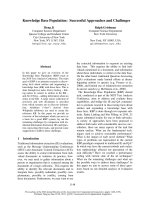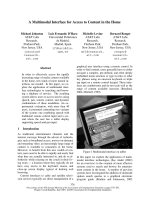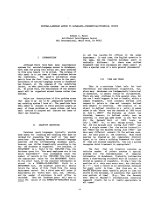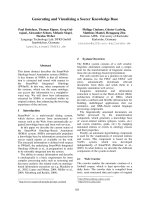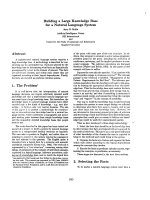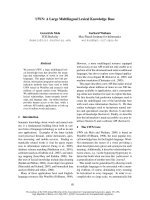VIALACTEA knowledge base homogenizing access to Milky Way data
Bạn đang xem bản rút gọn của tài liệu. Xem và tải ngay bản đầy đủ của tài liệu tại đây (173.15 KB, 11 trang )
VIALACTEA knowledge base
homogenizing access to Milky Way data
Marco Molinaroa , Robert Butoraa , Marilena Bandieramonteb , Ugo Beccianib , Massimo
Bresciac , Stefano Cavuotic , Alessandro Costab , Anna M. Di Giorgiod, Davide Eliad , Akos
Hajnale , Hermann Gabore , Peter Kacsuke , Scige J. Liud , Sergio Molinarid , Giuseppe Riccioc ,
Eugenio Schisanod , Eva Sciaccab , Riccardo Smaregliaa , and Fabio Vitellob
arXiv:1608.04526v1 [astro-ph.IM] 16 Aug 2016
a
INAF - Osservatorio Astronomico di Trieste, via G.B. Tiepolo 11 - 34143 Trieste, Italy
b
INAF - Osservatorio Astrofisico di Catania, Via S. Sofia 78 - 95123 Catania, Italy
c
INAF - Osservatorio Astronomico di Capodimonte, Salita Moiariello 16 - 80131 Napoli, Italy
d
INAF - Istituto di Astrofisica e Planetologia Spaziali, Area di Ricerca di Tor Vergata, via
Fosso del Cavaliere 100 - 00133 Roma, Italy
e
MTA-SZTAKI, 1111 Budapest, Kende u. 13-17, Hungary
ABSTRACT
The VIALACTEA project has a work package dedicated to “Tools and Infrastructure” and, inside it, a task for
the “Database and Virtual Observatory Infrastructure”. This task aims at providing an infrastructure to store
all the resources needed by the, more purposely, scientific work packages of the project itself. This infrastructure
includes a combination of: storage facilities, relational databases and web services on top of them, and has taken,
as a whole, the name of VIALACTEA Knowledge Base (VLKB). This contribution illustrates the current status
of this VLKB. It details the set of data resources put together; describes the database that allows data discovery
through VO inspired metadata mainteinance; illustrates the discovery, cutout and access services built on top of
the former two for the users to exploit the data content.
Keywords: Databases, VO, Data Access, Milky Way
1. INTRODUCTION
The VIALACTEA project goal is to bring to a common forum the major new-generation surveys of the Galactic
Plane in the radio band, both in thermal continuum and in atomic and molecular lines, from Europe-funded
space missions and ground-based facilities, to engage one of the fundamental challenges in Galactic astronomy:
to quantify in our galaxy the relationship between the physical agents responsible for the onset and the regulation
of star formation in a spiral galaxy and the resulting rate and efficiency of star formation, and obtain a “star
formation recipe” that will be a cornerstone to trace the star formation history of galaxies back to their formation.
Among the work packages the project is composed of, one incorporates the activities needed to ensure that a
computing infrastructure and a set of data-mining, machine-learning, visual analytics and 3D visualization tools
are in place according to astronomers specifications.
The input data that the computational tasks should start from, as well as the output results the various tasks
will provide form a knowledge base that is, in turn, the goal of one task of this latter work package.
This contribution focuses on this task, the creation and maintenance, as well as the access interfaces, of the
VIALACTEA Knowledge Base (VLKB).
Section 2 will briefly describe the project work packages and tasks and give a more detailed view of the “tools
and infrastructure” work package (Sec. 2.1), with specific attention to the VLKB (Sec. 2.1.1). Section 3 will
then focus on the heterogeneous content of the storage (Sec. 3.1) available to the VIALACTEA community and
Further author information: (Send correspondence to Marco Molinaro)
Marco Molinaro: E-mail: , Telephone: +39 040 3199 152
the database (Sec. 3.2) that contains the storage metadata descriptions as well as catalogued data consumed
or provided by the project’s scientific tasks. Next section (Sec. 4) will then describe the search and access
interfaces that live on top of the above data collections; Sec. 4.1 focuses on the generic TAP interface (Table
Access Protocol1 , an IVOA standard) that exposes the database content in an interoperable way while Sec. 4.2
describes in details the dedicated discovery and access interfaces that allow filtering of data collections and
retrieval of the actual data files.
2. PROJECT OVERVIEW
The VIALACTEA project consists of four scientific work packages (WPs), a technical one (WP 5, that we will
touch in more details in Sec. 2.1) and other packages dedicated to dissemination, management and coordination
activities. Scientific packages’ tasks span from diffuse and compact structure analysis (WP 1 & 2) to distance
estimation (WP 3) and their outputs are then combined into a global scenario of the galaxy as a star formation
engine within WP 4 tasks. All the scientific tasks need some data to start from and produce some output to be
preserved:
• diffuse structure analysis produce catalogues of filamentary and bubble structure out of continuum radio
surveys using morphological analysis and radiative transfer modeling;
• compact source analysis provides a catalogue of compact sources out of continuum surveys and combines it
with catalogues at different wavelengths to have a multi band catalogue to fit against synthetic protocluster
models (another project output);
• distance estimation uses kinematical analysis of existing radio spectroscopic surveys and project generated
3D extinction maps to produce distance estimation of compact sources or other diffuse regions of the galaxy
plane.
All of these tasks output are then combined into WP4 tasks for the final scientific goals of the project.
The goal of WP 5, “Tools and Infrastructures” is to provide technical support in running and developing the
tools and recipes needed by the scientific counterpart.
2.1 VIALACTEA Tools and Infrastructures
There are four main activities in this work package:
Database and Virtual Observatory Infrastructure: to have a common set of resources to be used for scientific input and collect the project outputs. This is what this paper is for, the main product of this activity
being the setup and maintenance of the VLKB and its interfaces;
Data Mining Systems: to develop intelligent integrated systems directly supporting scientific decision making
and situation awareness by dynamically integrating, correlating, fusing and analysing extremely large
volumes of disparate data resources and streams;
3D visual analytics systems: allowing the astronomer to easily conduct research activities using advanced
visual methods for multidimensional data and information visualization, real-time data interaction to carry
out complex tasks for multi-criteria data/metadata queries for subsample selection and further analysis, or
real-time control of data fitting to theoretical models;
Science Gateway: to enable workflows based on the analysis tools and recipes and run them through the
WS-PGRADE/gUSE gateway system.
The tools and infrastructure developed through these activities should bring the researcher from the input data
to the result in an easy reproducible way, moving, at least partially, the steps of data retrieval, decision making,
visual inspection of the information and/or results and job runs from manual tasks to automated ones.
The VLKB acts in this scenario as the data resource repository with interoperable capabilities and custom
access interfaces. As already mentioned, the resources collection will be reported in Sec. 3 and the interfaces on
top of them in the subsequent Sec. 4.
2.1.1 Database and Virtual Observatory Infrastructure
The task activity within which the VLKB has been developed was defined as the one to carry out the archival
goals of the project as well as the data repository for all of the initial data resources needed by the scientific
work packages.
The idea was to have a common resource to follow the VO guidelines for interoperability while paying specific
attention to the project needs. One of the main issues in keeping the pace with the IVOA standards has been to
develop a project on the most recent specifications the VO was discussing upon. This would have been of great
help in the VIALACTEA scenario if some specific internal requirements were not in conflict. The result is that
the VLKB and its interfaces are currently not completely developed using IVOA protocols, but are ready to be
mapped onto them given some time resource (which may be tricky since VIALACTEA is at the end of its life
cycle).
The actual result of this task activity (which will be better summarized in Sec. 5) is a resource composed
of a set of heterogeneous data collections of observational data, in form of images or multi-dimensional datasets
and catalogues, alongside database schemata and relations dedicated both to metadescription of the mentioned
data collections and catalogues produced by the project work package activities.
The discovery, access and retrieval solutions on top of these common resource (the VLKB) is based on an
IVOA TAP service for all of the database content that needs to be exposed to the community plus some dedicated
search, cutout and merge solutions for the 2D and 3D datasets available through the project. This latter secures
the datasets (which are a mix of public and private policy ones) and allows search also for project specific
datasets, like the 3D extinction maps of the galaxy produced inside the project itself.
3. VLKB DATA COLLECTIONS
The data content of the VLKB comes in two main archival formats:
• storage FITS files;
• relational database schemata.
In this section we describe them both as are currently available (or planned by the end of the project) following
the above distinction, instead of following an input vs. output categorization or a task-based one. Descriptions
will take into account:
• dataset origin: from within the project or mirror/redistribution of an existing resource;
• resource weight (in terms of datasets, file sizes, catalogue records);
The interfaces to discovery, access and retrieval of the resources is left to the following section (Sec. 4).
3.1 Storage Content
The storage contains files in FITS2 format only, but they’re rather heterogeneous. Those FITS files, indeed, span
from 2D images in the radio continuum to 3D FITS cubes containing radio velocity spectra at specific molecular
lines and also a collection of 3D extinction maps.
But the number of dimensions and type of axis is not the only difference between the various data collections
deployed. There are differences in coordinate system and sky frame references, galactic coordinates versus
equatorial ones to explicit the most easy one to handle, as well as degenerate axis references and multiple HDUs
or non-standard keywords in the FITS header.
Most prominent, however, were the actual observational differences, that is, the various surveys, and observational bands within them, that have been used in the scientific analysis of the VIALACTEA project. Taking into
accout what has been labeled as a sub-survey (i.e. a collection of data from a specific survey or pointed archive
referring to only one single molecular or band or other specific metadata), about 50 different data collections
have been put together to be searched and accessed as a unique resource.
Apart from the Hi-Gal sub-surveys, the core resource from which most of the VIALACTEA primary products are derived, all of the other resources were retrieved from already public repositories or released to the
VIALACTEA community but retaining their private data policy. That’s the reason why access to the VLKB
infrastructure has been secured and allowed only to the project’s members.
Tables 1, 2 and 3 summarize the sub-surveys data collections reporting minimal figures for the various FITS
file sets.
Table 1. VIALACTEA VLKB stored surveys consisting of FITS data cubes.
Name
sub-survey
# files
size [GB]
Name
sub-survey
# files
size [GB]
MOPRA
12CO
52
45
MALT90
HCO+
2012
23
MOPRA
13CO
52
30
MALT90
HCN
2012
23
MOPRA
C17O
51
14
MALT90
N2H+
2012
23
MOPRA
C18O
51
24
MALT90
HNC
2012
23
CHIMPS
13CO
224
18
MALT90
13C34N
2012
23
CHIMPS
C18O
223
20
MALT90
13CS
2012
23
CHaMP
HCO+
16
1.6
MALT90
C2H
2012
23
HOPS
H2O
11
14
MALT90
CH3CN
2012
23
HOPS
NH3 (1-1)
11
5.3
MALT90
H13CO+
2012
23
HOPS
NH3 (2-2)
11
5.3
MALT90
H41alpha
2012
23
FCRAO GRS
13CO
42
11
MALT90
HC13CCN
2012
23
ThrUMMS
12CO
23
13
MALT90
HC3N
2012
23
ThrUMMS
13CO
22
11
MALT90
HN13C
2012
23
ThrUMMS
C18O
23
11
MALT90
HNCO404
2012
23
ThrUMMS
CN
23
12
MALT90
HNCO413
2012
23
NANTEN
12CO
2
1.1
MALT90
SiO
2012
23
OGS
12CO
4
14
VGPS
HI
13
5.7
OGS
13CO
3
11
CGPS
HI
84
45
JCMT-HARP
12CO
92
24
SGPS
HI
13
4.4
Hi-Gal data, the survey tiles listed in Table 2 as well all the data derived from them (e.g. filaments, bubbles
and single band catalogue listed in Table 4) are private to the project. MOPRA, GRS, NANTEN, OGS have
been granted for usage inside the VIALACTEA project, but are covered by privacy policy. Extinction Map data
are private until the end of the project because they have been produced within the VIALACTEA project itself.
All the other data cube surveys and pointed archive listed in Table 1 and 2, are publicly available starting from
locations listed in Appendix A.
All of the above files, that sum up to about 1 TB and nearly 40 000 files, are of course only the archival
resource that needs to be made discoverable, accessible and retrievable to the community to enable the workflows
and analysis that are the goal of the project.
The first, obvious, step in this direction is the ingestion of the needed metadata in a database back end to
allow faster discovery and endpoint retrieval for accessibility. This is part of the content of the next subsection.
Table 2. VIALACTEA VLKB stored data collections consisting of 2D radio continuum images.
Name
sub-survey
# files
size [GB]
CORNISH
5 GHz
1408
84
MAGPIS
1.4GHz
352
1.4
Hi-Gal
70µm
166
7.2
Hi-Gal
160µm
166
3.7
Hi-Gal
250µm
166
2.2
Hi-Gal
350µm
166
1.3
Hi-Gal
500µm
166
0.6
MIPSGAL
24µm
339
13
WISE
3.4µm
694
44
WISE
4.6µm
694
44
WISE
12µm
694
44
WISE
22µm
694
44
Table 3. VIALACTEA VLKB stored data collections.
Name
sub-survey
# files
size [MB]
Extinction Maps
5 arcmin resolution
72
76
Extinction Maps
10 arcmin resolution
72
18
3.2 Database Content
Alongside the FITS data collections, a relational database (RDB) completes the VLKB resource content in terms
of data information. This RDB (using a MySQL RDBMS) contains various types and blocks of information
needed by the project. To mimic the logic underlying the project work packages subdivision, a set of schemata
has been prepared to host the information.
Filaments & Bubbles. This database schema holds all the information related to the diffuse objects identified
from Hi-Gal continuum tiles (for filaments) and Hi-Gal and CORNISH tiles (for bubbles).
Filamentary structures are described using a set of 3 tables, identifying filaments as the primary object,
branches as the “linear” components within them and their spines, and nodes as the connection points of
the various branch segments that compose a filament.
Bubbles are described as a unique catalogue of diffuse objectS, because their roundish shape doesn’t require
further relationships among their components.
Both filaments and bubbles tables are completed with positional and global details plus contour information.
This latter is represented in two ways: an ordered sequence of sky positions (i.e. a polygon outlining the
diffuse structure) and a reference to a FITS file in MOC format (Multi-Order Coverage Map,3 an IVOA
Recommendation), that is an HEALPix4 tessellation of the diffuse object’s area to be used for easier
cross-match with other positional features in the VLKB or other databases.
Compact Sources. This schema contains all the single band catalogues used by the project to build up a
bandmerged catalogue of compact sources. The primary input of the band merge task are the 5 single
band catalogues derived from the Hi-Gal images through the CuTEx5 tool (refined as a deliverable of the
VIALACTEA project).
Alongside this catalogues, other have been used to build up a multi band catalogue of the galactic compact
sources. The full single band catalogue listing includes: Hi-Gal (PACS and SPIR bands), ATLASGAL,
BGPS, MIPSGAL, MSX and WISE (bands W3 and W4) catalogues for the galactic plane. The bandmerged
catalogue is produced from these ones using data mining techniques included in the QFullTree tool delivered
by the VIALACTEA project itself.
This schema includes also other content, not used in the band-merging effort of the project, but used in
the SED scenario investigated by the project. One table is devoted to the grid of synthetic protocluster
evolutionary models (based on Robitaille6 models and delivered through the project); this sums up to
20 million SED records to synthesize energy distributions in the bands used by the band-merging effort.
Another one is meant to keep track of the velocity information processed using the radio cubes FITS and
database through the Peak Finder tool developed by VIALACTEA WP3 members to be later used in the
distance estimation process of the various sources on the galactic plane.
Radio Cubes. All the metadata information about the stored FITS files and needed for the search and access
interfaces is contained in this schema. This means, currently, all the sky frame boundaries needed for the
discovery phase plus the actual location in the storage for data processing (cutout and merge) and retrieval.
Alongside the datasets minimal descriptions this schema includes also a table with a the description of all
the sub-surveys to let the consumer applications (currently the Visual Analytics one developed within the
project) identify the relevant sub-survey for the user.
This is probably the schema that may see more changes in the last phases of the project, if resources allow
to move to a better VO compliant scenario. In that case probably an ObsCore7 table may take the role of
part of the current FITS datasets meta-descriptions.
TAP SCHEMA. A last schema is kept in the VLKB to describe all of the schemata, tables, columns and
their keys and indexes to be deployed through the TAP interface. This is the schema that is part of the
IVOA TAP specification and acts as a counterpart to the information schema that is built in the RDBMS
systems. Every change in the exposed database architecture that the VLKB wants to make visible to the
user as a description counterpart in this schema.
Table 4 summarizes the various catalogues ingested in the VLKB database part including the number of
records. Not all of the database table details have been included, because this is highly dependent on the usage
and, given the project is still ongoing, they will vary a lot.
As for the datasets, some of these are publicly available, other are covered by a privacy policy. Filaments
and bubbles catalogues and SED models, being products of the project, are private until the end of the project
itself. Hi-Gal derived data is part of the core of the project, and thus it is also covered by privacy policy. The
other catalogues are public and available as listed in Appendix A.
Please note that, since the VIALACTEA project is not yet finished and delivered, the above figures and
contents may not be exact, but anyway they give a good idea of the contents and goals of the VLKB.
4. VLKB INTERFACES
All the data and metadata contents described in Section 3 would be, of course, useless if not somehow discoverable and accessible. This is the goal of the interfaces that have been put on top of the database and storage
system. The following subsections describe the two consuming interface systems that have been set up for the
VIALACTEA community: a TAP interface (Sec. 4.1) and a set of dedicated interfaces (Sec. 4.2) to consume to
stored FITS datasets.
4.1 TAP interface
The IVOA Table Access Protocol is a specification to allow generic table-sets to be deployed as VO resources.
It aims at homogenizing database access in the astrophysical research field, adding specific metadata content for
discoverability and interoperability among different resources.
Table 4. VIALACTEA VLKB catalogue figures (rounded). Please note that figures may be partial or may differ from the
final VLKB version because work is still in progress on the project at the time of this writing.
Catalogue
# records
Filaments
30 K
Filament Branches
150 K
Bubbles
5K
SED Models
20 M
WISE
28 M
ATLASGAL
10 K
BGPS
8.6 K
Hi-Gal (70 µm)
160 K
Hi-Gal (160 µm)
600 K
Hi-Gal (250 µm)
470 K
Hi-Gal (350 µm)
250 K
Hi-Gal (500 µm)
130 K
MIPSGAL
2.6 M
MSX
400 K
The choice to have a TAP interface on top of the VLKB database part was made to allow both positional
searches (that could have been done using a Simple Cone Search8 protocol) and generic searches through the
fields of the ingested data, also considering cross correlations between multiple tables available through the
service.
The TAP service has been deployed using the IA2 TAP implementation∗ . It runs inside a GlassFish JAVA
EE web container and it has been developed on top of the openCADC† libraries by the Canadian Astronomy
Data Center‡ .
Since the data ingested in the database is partly public and partly private data, the access to the interface
has been secured. The authentication mechanism is currently being re-shaped to allow single user access (as
opposite to the current project membership credentials), also in view of the user space related to the output
products of the cutout and merge services described hereafter.
The TAP service, in short, serves everything included in the filaments, bubbles, compact sources, sed models
and velocity peak store resource span and, in the future, it is intended to support also the radio cubes and
images metadata. The visualization tool developed within the VIALACTEA project consumes this TAP service
to provide the user with the relevant information to display alongside images and cubes.
4.2 Discovery, Cutout & Merge interfaces
While the TAP interface is useful for generic tabular access, it is less powerful (at least alone) to perform positional
discovery and is not designed to provide direct access to data files (unless one is willing only to retrieve a full
file).
However, the requirements of the project were also to be able to:
∗
IA2TAP
is
part
of
the
IA2
/>†
/>‡
/>
Data
Access
Layer
service
generation
tools:
• identify what files’ content overlap a region along a specific line of sight on the celestial sphere and described
by a circle or a rectangular range around it;
• cutout the files on positional constraints and also on the velocity axis (if 3D cubes were investigated) to
allow for efficient data transport on the net and work only on the relevant part of data;
• merge adjacent files (from the same sub-survey, i.e. no information post-processing during the merge phase)
into a single image/cube based on positional and velocity bounds.
IVOA specifications are currently covering the second point (see SODA§ ), were in the phase of describing the
first one when the VIALACTEA project was kicked-off (the SIAv29 protocol) and foresee the third one in the
near future (probably a minor revision of SODA).
Thus, even if keeping an eye on what IVOA was providing, a custom solution was undertook to have the
discovery and access interfaces for VIALACTEA in place. This custom solution allowed also to work directly in
galactic coordinates, while in the IVOA interfaces equatorial coordinates are prioritized.
The developed interface architecture is now composed of three services that share the same parametric query
solution for positions, bound descriptions, sub-survey selection and are able to search and cutout indifferently
of the underlying FITS header metadata (at least as far the WCS10, 11 descriptors are correctly in place and
understood by the AST¶ libraries). Specifically, the headers of various sub-surveys are passed to AST12 library
which is used to perform region overlap, and boundary computations. The AST library is a C-library so the
JNI technology is used to access C-code from Java domain. Most of the Java-code is performing interfacing.
Essential work is done ”below” JNI in C. We process the partial results from AST in C-domain and then return
the final results to Java domain. So we cross the JNI once per request.
Similar approach is taken also for the merge service, where the used engine is Montagek . The merging service
internally adds 3D-datacubes which are the result of the cutout service.
Issues on header metadata content as been solved, as far as possible, through corrected information ingestion
at database level, trying not to change the original retrieved FITS, especially in the case of mirroring pre- existing
resources. Data content of the FITS files also has been kept to a minimum, untouched in the cutout service, at
most regridded along the third axis in the merge service if the adjacent FITS had different binning on that axis.
The set of three services, secured like the TAP interface to prevent unauthorized access to private data,
deploys to the project’s members all the images, cubes and extinction maps summarized in Tables 1, 2 and 3.
The VIALACTEA visualization tool as well as other task tools make use of these services endpoints to prepare
the input data for their tasks.
5. PLANNED VLKB SETUP
The data resources described in Section 3 and the interfaces reported in the previous Section 4 build up what
was the goal of the VIALACTEA Work Package 5 Task 1. Currently the development is in finalization, but all
what as been reported is planned to be ready and consumable by the end of September 2016 (i.e. the end of the
funded project). Figure 1 gives a quick view of the architecture of the full system.
Depending mainly on time resource availability, more efficient discovery and access solutions, based on a
modular and distributed architecture, may be set in place and a better VO compliance can be achieved.
One major point, not detailed in this paper, but planned to be ready by the end of the project, is the
improvement of positional searches with the usage of HEALPix tessellation, in particular a dedicated service
should be set up to allow direct, quick, cross match on positions between diffuse objects (filaments and bubbles)
and compact sources. Given the large amount of records in the DB, this would be a welcome addition to the
available interfaces.
§
SODA Proposed Recommendation /> />k
/>¶
Figure 1. VLKB content and interfaces overview. Shown, on the interfaces layer, the positional cross match service based
on HEALPix tessellation, not yet fully developed.
Also planned is the change from a membership-wide user to a single-based user authentication. This as the
goal also to help maintain the staging area for the cutout and merged FITS outputs of the access interfaces, that
otherwise may grow indefinitely and with no choice, for the user, to retrieve a product already calculated.
6. CONCLUSIONS
Building a data infrastructure to cover large part of the radio data for the galactic plane has been quite a
big challenge, especially if undertaken with minimal resources and trying to cope with the short schedule of a
three-year project with frequently updated requirements.
In this view the VLKB development has profited from the knowledge and experience available at the INAF
IA2 data center, not last the VO experience that was highly useful in defining the solutions for discovery and
access to the data, even if not directly available in terms of IVOA Recommendations.
One main critic that may be addressed to the solutions put in place is that large part of the data has been
mirrored in a single location to be again deployed to the community. Indeed, initially the idea was to build
as much as possible over existing resources and services; however most of the data re-used fell behind custom
interfaces, usually graphical web forms, that were difficult to access programmatically and attach to a common
interface solution.
Considering that the VIALACTEA project is now running to its final deadline, it is difficult to foresee what
improvements may be made to the VLKB, besides minimal maintenance; however, if further development and
progress were to be foreseen, for sure developing a real VO compliant architecture will be definitely of a benefit
to the community not to have future projects develop again mirrored interfaces to already existing resources.
APPENDIX A. PUBLIC DATA
Here follows the listing of all the public data used in developing the VLKB content.
A.1 FITS cubes
Radio cubes surveys and pointed archives.
CHIMP: />CHaMP: />HOPS: />ThrUMMS: />JCMT-HARPS: />MALT90: />VGPS: />CGPS: />SPGS: />
A.2 FITS images
Continuum surveys.
CORNISH: />MAGPIS: />MIPSGAL: />WISE: />
A.3 Catalogues
Single band catalogues used in band-merging.
WISE: />ATLASGAL: />BGPS: />MIPSGAL: />MSX: />
ACKNOWLEDGMENTS
This work has been developed under the European Community 7th Framework Programme, Grant Agreement
607380, VIALACTEA - The Milky Way as a Star formation engine.
The VLKB resource data and metadata are highly depending on external public and private sources. We
acknowledge the efforts of the staff of the primary repositories and archives from which we retrieved the data to
be offered to the VIALACTEA members and, at the end of the project, to the astrophysical community (all the
relevant starting points are listed in Appendix A).
This research made use of Montage. It is funded by the National Science Foundation under Grant Number
ACI-1440620, and was previously funded by the National Aeronautics and Space Administration’s Earth Science Technology Office, Computation Technologies Project, under Cooperative Agreement Number NCC5-626
between NASA and the California Institute of Technology.
REFERENCES
[1] Dowler, P., Rixon, G., and Tody, D., “Table Access Protocol Version 1.0.” IVOA Recommendation 27
March 2010 (Mar. 2010).
[2] Pence, W. D., Chiappetti, L., Page, C. G., Shaw, R. A., and Stobie, E., “Definition of the Flexible Image
Transport System (FITS), version 3.0,” Astronomy and Astrophysics 524, A42 (Dec. 2010).
[3] Fernique, P., Boch, T., Donaldson, T., Durand, D., O’Mullane, W., Reinecke, M., and Taylor, M., “MOC HEALPix Multi-Order Coverage map Version 1.0.” IVOA Recommendation 02 June 2014 (June 2014).
[4] G´orski, K. M., Hivon, E., Banday, A. J., Wandelt, B. D., Hansen, F. K., Reinecke, M., and Bartelmann,
M., “HEALPix: A Framework for High-Resolution Discretization and Fast Analysis of Data Distributed on
the Sphere,” Astrophysical Journal 622, 759–771 (Apr. 2005).
[5] Molinari, S., Schisano, E., Faustini, F., Pestalozzi, M., di Giorgio, A. M., and Liu, S., “Source extraction
and photometry for the far-infrared and sub-millimeter continuum in the presence of complex backgrounds,”
Astronomy and Astrophysics 530, A133 (June 2011).
[6] Robitaille, T. P., Whitney, B. A., Indebetouw, R., Wood, K., and Denzmore, P., “Interpreting Spectral
Energy Distributions from Young Stellar Objects. I. A Grid of 200,000 YSO Model SEDs,” Astrophysical
Journal Suppl. 167, 256–285 (Dec. 2006).
[7] Tody, D., Micol, A., Durand, D., Louys, M., Bonnarel, F., Schade, D., Dowler, P., Michel, L., Salgado, J.,
Chilingarian, I., Rino, B., de Dios Santander, J., and Skoda, P., “Observation Data Model Core Components,
its Implementation in the Table Access Protocol Version 1.0.” IVOA Recommendation 28 October 2011 (Oct.
2011).
[8] Plante, R., Williams, R., Hanisch, R., and Szalay, A., “Simple Cone Search Version 1.03.” IVOA Recommendation 22 February 2008 (Feb. 2008).
[9] Dowler, P., Bonnarel, F., and Tody, D., “IVOA Simple Image Access Version 2.0.” IVOA Recommendation
23 December 2015 (Dec. 2015).
[10] Calabretta, M. R. and Greisen, E. W., “Representations of celestial coordinates in FITS,” Astronomy and
Astrophysics 395, 1077–1122 (Dec. 2002).
[11] Greisen, E. W., Calabretta, M. R., Valdes, F. G., and Allen, S. L., “Representations of spectral coordinates
in FITS,” Astronomy and Astrophysics 446, 747–771 (Feb. 2006).
[12] Berry, D. S., Warren-Smith, R. F., and Jenness, T., “AST: A library for modelling and manipulating
coordinate systems,” Astronomy and Computing 15, 33–49 (Apr. 2016).

